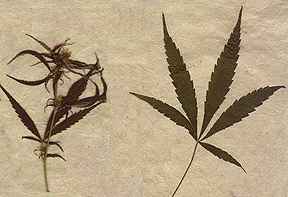 |
A Brief History of Medical Cannabis
by Rob Christopher
| The first recorded use of Cannabis as a medicine was a Chinese Herbal publishedduring the reign of Chen Nung some 5,000 years ago. There is also a long historyof its use in India, China, The Middle East, South-East Asia, Africa and SouthAmerica. One of the first Western physicians to show a keen interest in Cannabis was W.B.O'Shaughnessey who observed its use while working in India at the Medical Collegeof Calcutta. In 1839, he published a report that concluded that Cannabis was aneffective analgesic and "an anti convulsive remedy of thegreatest value." In 1842, O'Shaughnessey returned to England with his Cannabis "tincture"; and its usesoon became so widespread that it was being prescribed by doctors all over the world fora whole host of ailments. Queen Victoria used Cannabis to relieve the discomfortof menstrual cramps. Coincidentally, it was during the reign of Queen Victoria(1837-1901) that Cannabis had its heyday as a medicine, with a hundred medical papers being published, recommending the use of Cannabis for thetreatment of numerous ailments and discomforts. Within that same period, Cannabiswas placed consistently within the top three of the most commonly-prescribed medications. In 1937, the medical use of Cannabis was severely restricted by the MarijuanaTransfer Act. During the 1960s, federally-sponsored research began to show that, contrary topopular belief, Cannabis was not a soul-destroying drug, but was a substance ofincredible therapeutic potential. In 1971, Cannabis was made illegal for Medical use under the Misuse of Drugs Act.This was despite the findings of the recent Royal Commission conducted byBaroness Wootton, that "Preparations of Cannabis and itsderivatives should continue to be available on prescription for purposes ofmedical treatment and research." In 1976, the US government put an end to federal research into Cannabis, leaving future progress in the hands ofprivate Pharmaceutical Companies who were to be entirely self-funding. The hoped-for payoff for the government was that thepharmaceuticals would come up with a patentable synthetic form of Cannabis at nocost to themselves and with a promise of no "high." Eli Lilly have come out with Nabilone and Marinol, which, it is alleged, are farless effective than herbal Cannabis and have some very disturbing side effects. In 1986, after years of campaigning by pressure-groups, public hearingson the therapeutic potential of Cannabis were instigated. The hearings were overseen byadministrative law judge, Francis Young, who after over two years of proceedingsruled that "Marijuana, in its natural form, is one of the safest therapeuticallyactive substances known to Man." He also recommended that it be made legally available for doctors to prescribe. The DEA (Drugs EnforcementAgency) rejected these findings, calling them a "dangerous and cruel hoax." Herbal Cannabis remains a Schedule 1 Drug (a drug of no medical value) bothhere in Britain and in the United States. If you are sickened by the fact Cannabis remains illegal for medical use, thenplease write to your MP urging them to support Paul Flynn MPs EDM 782 calling forthe legalisation of Cannabis for medical use. On 8th November, the TV programme "The Time, the Place" conducted a phone poll onthe medical use of Cannabis. Over 30,000 phoned in and 92% were in favour oflegalising Cannabis for medical use. |
| Back to Menu... |